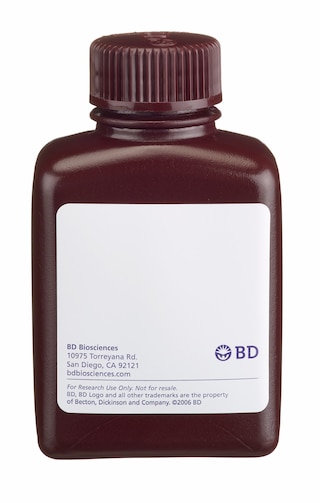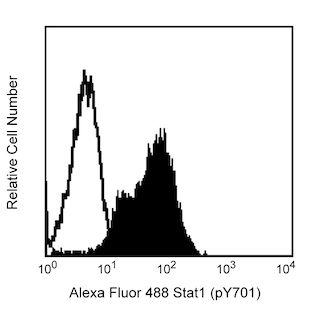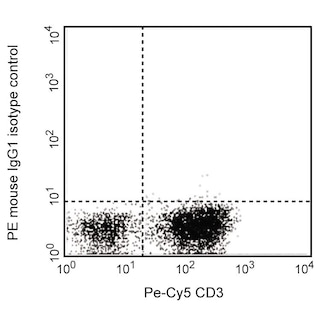Old Browser
This page has been recently translated and is available in French now.
Looks like you're visiting us from {countryName}.
Would you like to stay on the current country site or be switched to your country?


.png)

Flow cytometry analysis of PE anti Nanog on mouse embryonic stem (ES) cells. Mouse ES-E14TG2a (ATCC, Cat. No. CRL-1821) cells were fixed (BD Cytofix™ buffer, Cat. No. 554655) for 10 minutes at 37 C, permeabilized with BD™ Phosflow Perm Buffer III (Cat. No. 558050) on ice for 30 minutes, and then stained with either PE Mouse anti-Nanog (solid line) or PE Mouse IgG1,k Isotype Control (Cat. No. 554680, dashed line). This antibody also works in BD™ Phosflow Perm Buffer I and II. Flow cytometry was performed on a BD FACSCanto™ II flow cytometry system.
.png)

BD Pharmingen™ PE Mouse anti-Mouse Nanog
.png)
Regulatory Status Legend
Any use of products other than the permitted use without the express written authorization of Becton, Dickinson and Company is strictly prohibited.
Preparation And Storage
Product Notices
- This reagent has been pre-diluted for use at the recommended Volume per Test. We typically use 1 × 10^6 cells in a 100-µl experimental sample (a test).
- Please refer to www.bdbiosciences.com/us/s/resources for technical protocols.
- For fluorochrome spectra and suitable instrument settings, please refer to our Multicolor Flow Cytometry web page at www.bdbiosciences.com/colors.
- Caution: Sodium azide yields highly toxic hydrazoic acid under acidic conditions. Dilute azide compounds in running water before discarding to avoid accumulation of potentially explosive deposits in plumbing.
- Source of all serum proteins is from USDA inspected abattoirs located in the United States.
Companion Products



The M55-312 monoclonal antibody reacts with mouse Nanog (named for Tir Na Nog, the land of the ever-young of Celtic mythology), which is a homeobox transcription factor required for the maintenance of the undifferentiated state of pluripotent stem cells. Nanog expression counteracts the differentiation-promoting signals induced by the extrinsic factors LIF (Leukemia Inhibitory Factor) and BMP (Bone Morphogenic Protein). When Nanog expression is down-regulated, cell differentiation can proceed. Proteins that regulate Nanog expression include transcription factors Oct4, SOX2, FoxD3, and Tcf3 and tumor suppressor p53.

Development References (6)
-
Chambers I, Colby D, Robertson M, et al. Functional expression cloning of Nanog, a pluripotency sustaining factor in embryonic stem cells. Cell. 2003; 113:643-655. (Biology). View Reference
-
Chambers I. The molecular basis of pluripotency in mouse embryonic stem cells. Cloning Stem Cells. 2004; 6(4):386-391. (Biology). View Reference
-
Mitsui K, Tokuzawa Y, Itoh H, et al. The homeoprotein Nanog is required for maintenance of pluripotency in mouse epiblast and ES cells. Cell. 2003; 113:631-642. (Biology). View Reference
-
Pan G, Thomson JA. Nanog and transcriptional networks in embryonic stem cell pluripotency. Cell Res. 2007; 17:42-49. (Biology). View Reference
-
Sun Y, Li H, Yang H, Rao MS, Zhan M. Mechanisms controlling embryonic stem cell self-renewal and differentiation. Crit Rev Eukaryot Gene Expr.. 2006; 16(3):211-231. (Biology). View Reference
-
Suzuki A, Raya A, Kawakami Y, et al. Nanog binds to Smad1 and blocks bone morphogenetic protein-induced differentiation of embryonic stem cells. Proc Natl Acad Sci U S A. 2006; 103(27):10294-10299. (Biology). View Reference
Please refer to Support Documents for Quality Certificates
Global - Refer to manufacturer's instructions for use and related User Manuals and Technical data sheets before using this products as described
Comparisons, where applicable, are made against older BD Technology, manual methods or are general performance claims. Comparisons are not made against non-BD technologies, unless otherwise noted.
For Research Use Only. Not for use in diagnostic or therapeutic procedures.
Report a Site Issue
This form is intended to help us improve our website experience. For other support, please visit our Contact Us page.